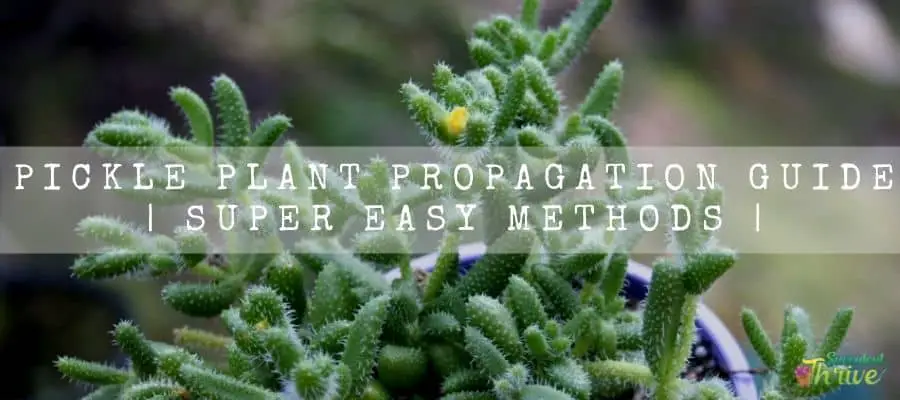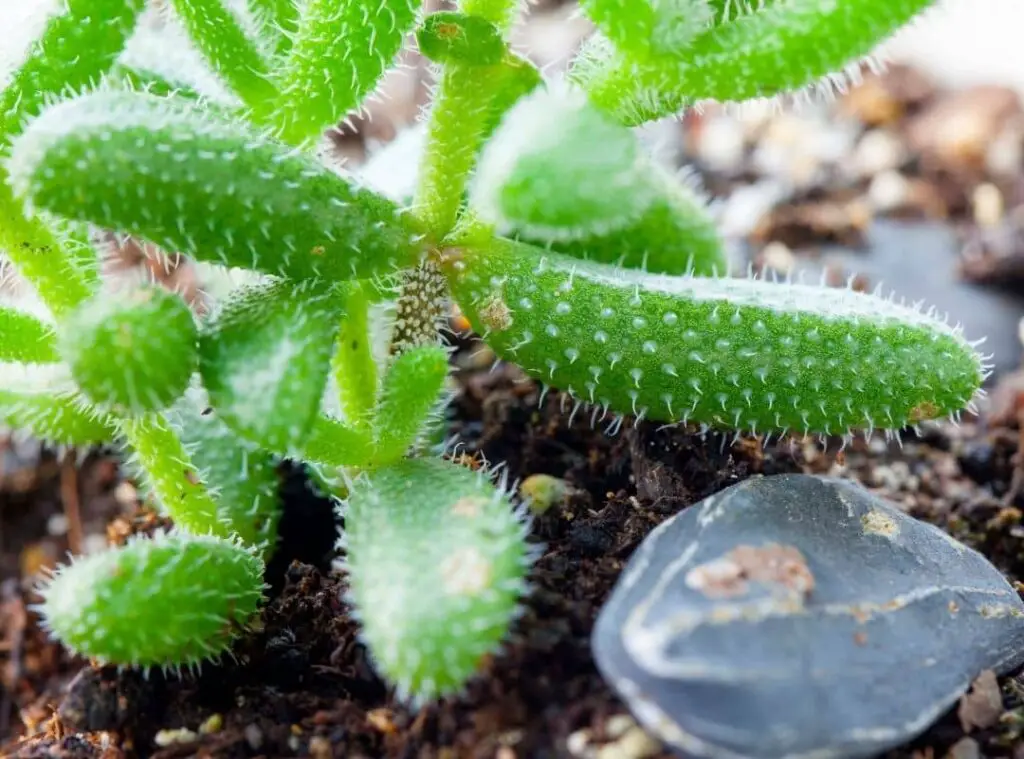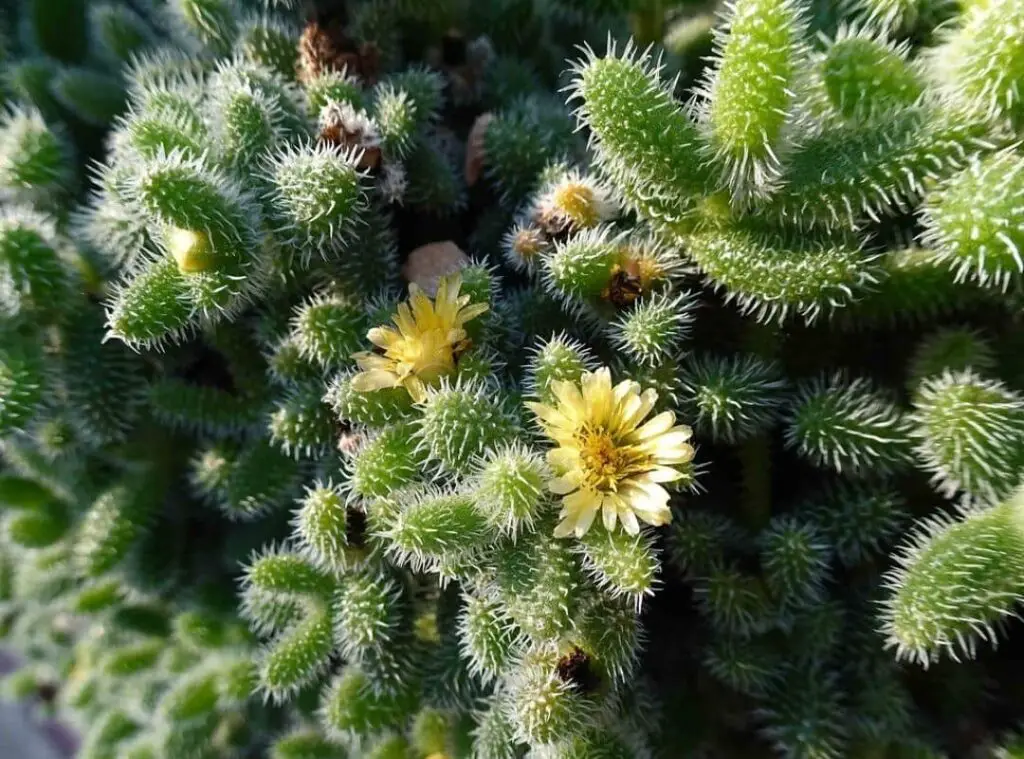You can conduct Pickle plant propagation by using cuttings and division methods. Besides, you may also use their seeds for propagation.
So, this is a comprehensive guide on how to conduct the propagation of the Pickle plants properly and the after-care treatments you need to practice.
Pickle plant is a plant which belongs to the family Asteraceae. These are endemic plants to South Africa. Pickle plants are wonderful flowering plants as well.
In fact, they produce flowers in red or in bright orange during spring or in summer. Pickle plants are known as ice plants. Pickle plants would get as tall as 45 cm ( 20 inches ( when they grow to their best potential.

If I elaborate further on their leaves, they would be bright green to dark green in color. Further those leaves would carry small spots on them as well.
Those leaves are plump and tend to take a little gherkin shape. Pickle plants have soft hairs as well. These adorable beauties bring so much happiness when they grow to their best.
Pickle plant propagation by cuttings
You can use stem cuttings of the pickle plants to propagate them and it is a simple and an easy process.
All you need to do is to use a clean sharp pair of scissors or pruners and then snip some cuttings off from the Pickle plants carefully. Ensure the cuttings are 2.5- 3 inches in length.
Next remove the leaves in the cuttings bottom section. After that let them wither and allow them to develop callus for a couple of days.
After that, you need to replant them in a soil mix which is fast draining. Spring , summer or fall would be the best seasons to conduct propagation of the Pickle plants.
Pickle plant propagation by division?
If you wish to propagate the Pickle plants by division, you need to first wait until spring comes. All you need to do is to divide the pickle plants and grow them in a soil mix which has excellent drainage.

Do they produce seeds?
Pickle plants produce seeds. They are useful in the propagation process as well.
However, since these are slow growing sets of plants, you need to be a patient gardener to try this method.
Literally , the seed propagation method is time consuming, and you need to stay patient until you get to see the results of it
However, if you wish to do this method, you can do this on the plants which you grow outdoors. If you have indoor grown pickle plants, it is best to conduct the cutting propagation method.
However, to do that, you have to simply scatter the seeds on a soil layer and expose them for bright indirect sunlight so that it would help them germinate. Refrain from covering the specimen though.
Do they produce offsets?
Pickle plants produce offsets freely. If you wish to propagate the Pickle plants from its offsets, you can simply remove them from the soil whilst using a sterile knife.
However, before you plant them, ensure that they wither and develop callus on the cut wounds. After that , you need to replant them in a soil mxi which has a fast drainage.
Can you root the Pickle plant in water?
You can propagate the Pickle plants in water, and you can continue with the general practice of the succulent water propagation method for these plants as well.
Water propagation method is not that messy when we compare it with the soil propagation method.
You can simply use the Pickle plants’ stem cuttings and conduct the propagation in water. You may also dip the cuttings in a rooting hormone so that it will speed up the propagation process.
Further keep in mind to take off the plants from water at the right time unless it would be difficult for them to survive in the soil when you grow them in the soil.

How to treat after propagation
Watering requirement of the Pickle plants
Watering the Pickle plants properly is very important when you take care of Pickle plants after propagating them.
Pickle plants do not want heavy watering simply due to the fact that they are a succulent type. However, it is vital that you water them moderately and let them wither after that.
If you end up over watering them, it will result in the death of the plants, and this is a common mistake which many gardeners tend to make.
Before you water the Pickle plants, you need to check whether their soil is damp or dry. If you end up watering the wet and soggy soil more and more, it would create a fatal impact on them as aforementioned.
Literally you need to water them more often during summer. Ideally once every week or once every half a week. You can minimize watering them to once every month during winter.
If you spot your Pickle plants leaves are drooping and soft you need to resume watering them immediately as those are signs of lack of water.
So, literally you should never let the Pickle plants sit in water and that is the most important thing you need to keep in mind when taking care of them.
Sunlight requirement of the Pickle plants
Pickle plants would prefer to have Full sunlight in the morning hours and partial shade in the afternoon.
If you have grown them indoors, you can shift them outdoors during morning hours and place them near a balcony or even in your garden during that time.
Just like the rest of other succulents and cacti, Pickle plants also prefer to have adequate sunlight. If you grow them deprived of sunlight, it will directly impact the healthy growth of the Pickle plants.
Literally their leaves will be dull and drooping. Further their branches would be slender too.
The exposure for sufficient sunlight will make them arrange the Pickle plants’ leaves closely. Moreover, their branches will also be thick.
Having said that, you should protect the plants from intense sunlight during the hot summer period. Unless it would result in sunburns of the plants.
Temperature requirement of the Pickle plants
In terms of the right temperature levels. they would prefer to have warm weather right throughout.
Ideally, a temperature range of 15 degrees Celsius – 25 degrees Celsius would be healthy for the Pickle plants.
The minimum temperature they can stand in winter is up to 5 degrees Celsius. Pickle plants would go dormant when the summer temperature exceeds 30 degrees Celsius.
Soil requirement of Pickle plants
Pickle plants require a rich soil mix which has excellent drainage as well. Having said that Pickle plants are not fuzzy when it comes to the soil mixes.
As long as they are well drained, Pickle plants will grow well and healthily. Cactus soil mix or a succulent soil mix would suit them the best.
However, you need to add coarse sand and perlite as they would better drain the soil mixes.
Fertilizer requirement of the Pickle plants
Pickle plants do not want regular fertilizers simply because they are used to grow in semi-arid places in South Africa.
Having said that, if you feed them with a cacti and succulent liquid standard fertilizer it would provide an extra amount of fertilizer. Ensure that you do not overfeed them as if not it would result in a leggy growth of the plants.
Instead of the aforementioned fertilizers, you may also use an organic fertilizer as well.
However, no matter what fertilizer you add, you should ensure that you dilute them and only apply. Moreover, avoid spilling fertilizers on the leaves as it would also be unhealthy for the Pickle plants.
Right pot type of the Pickle plants
Pickle plants’ optimal growth would be beneficial if you grow them in a porous material pot. Moreover, ensure that it consists of a draining hole as well.
Conclusion
Before concluding, I hope you will find this article useful for you and now that you are confident in handling the propagation of the Pickle plants.
Keep in mind the above after care tips since it is crucial that you look after them well even after completing the propagation of them.
Read Next : Thimble Cactus Propagation | The Unbeatable Guide | Bunny Ears Cactus Propagation | By Cuttings, Seeds And Offsets |
